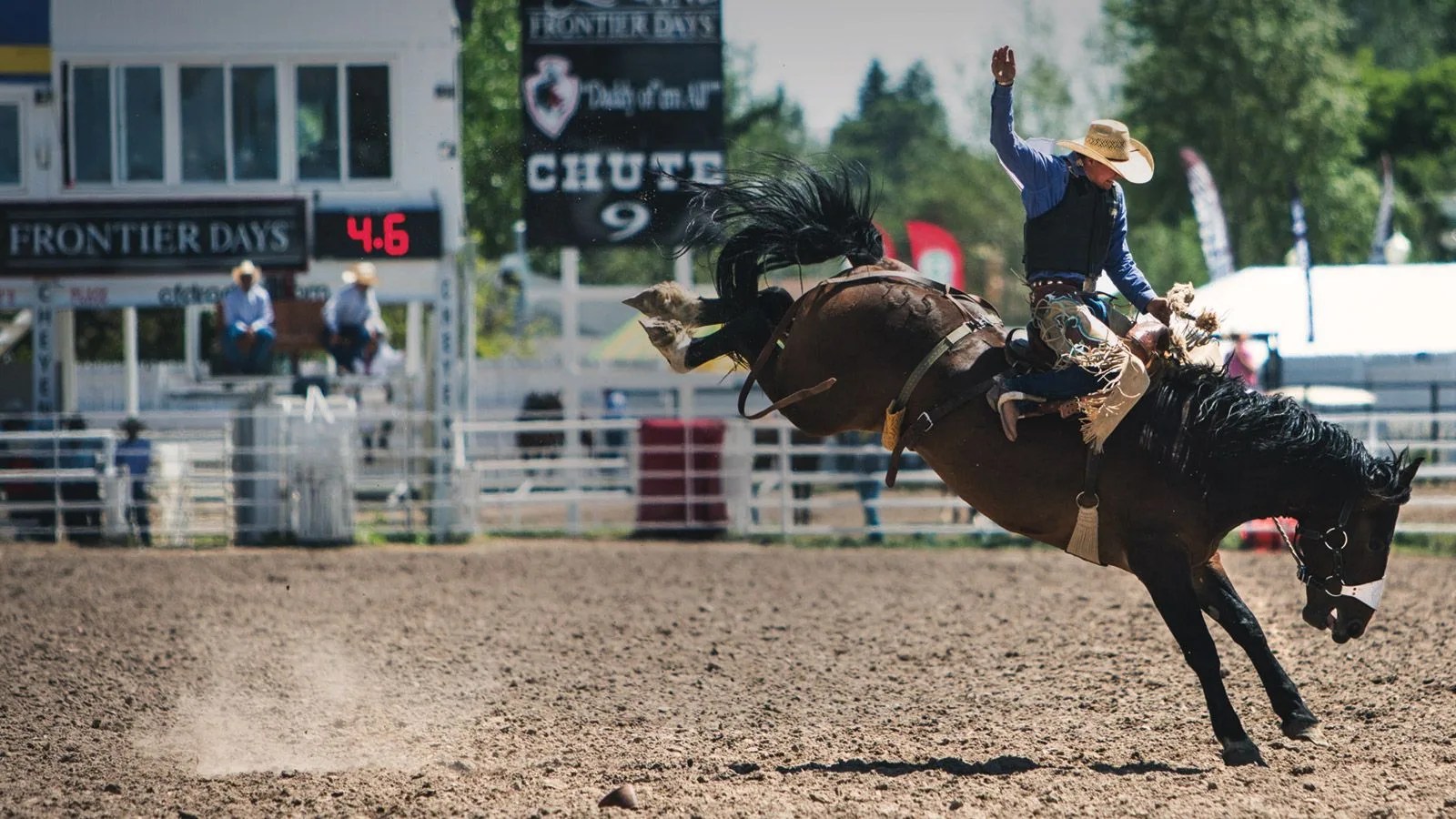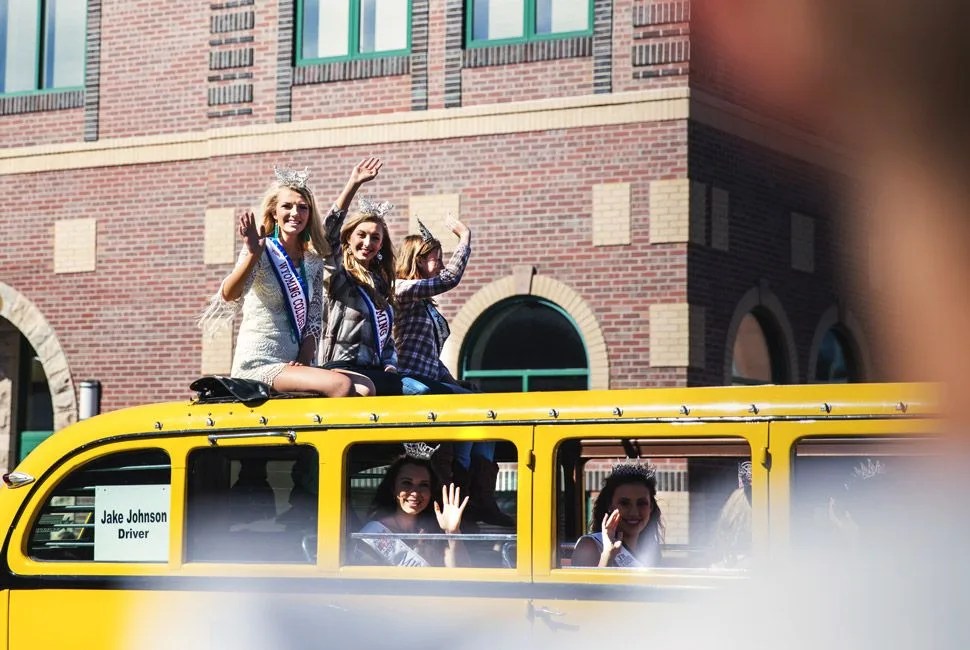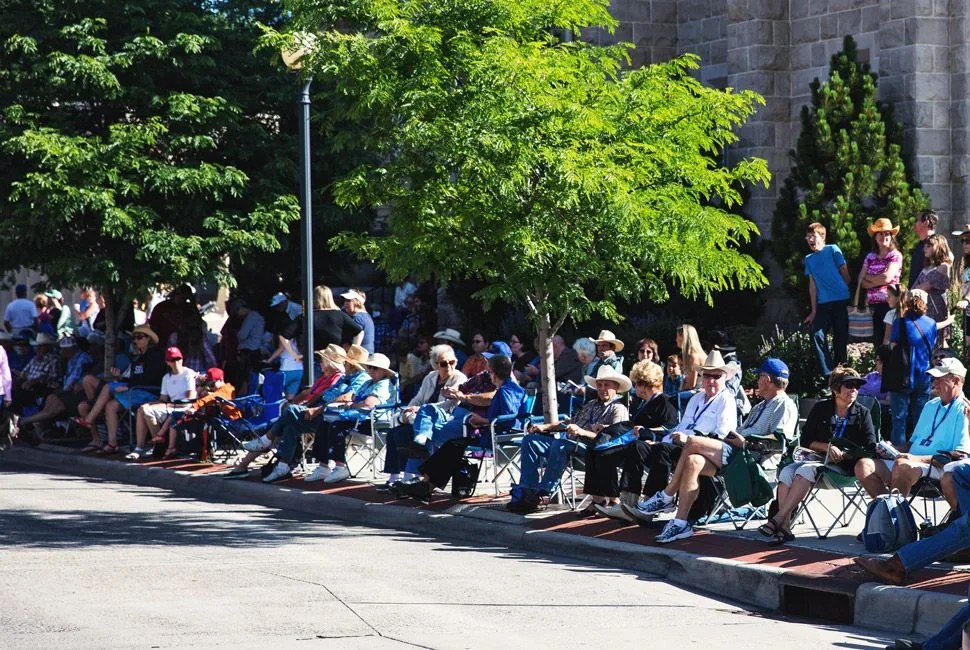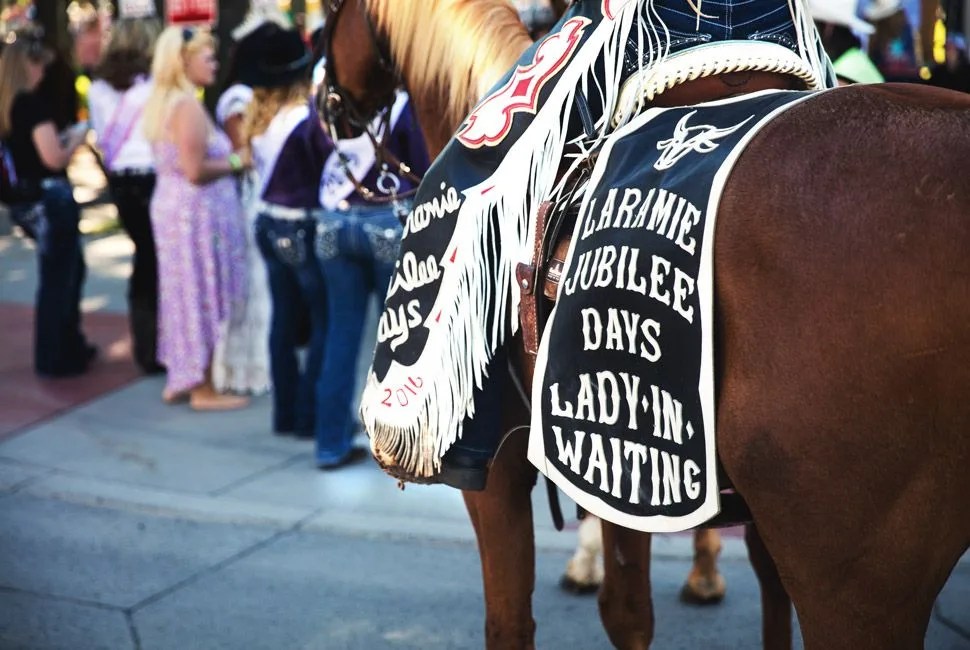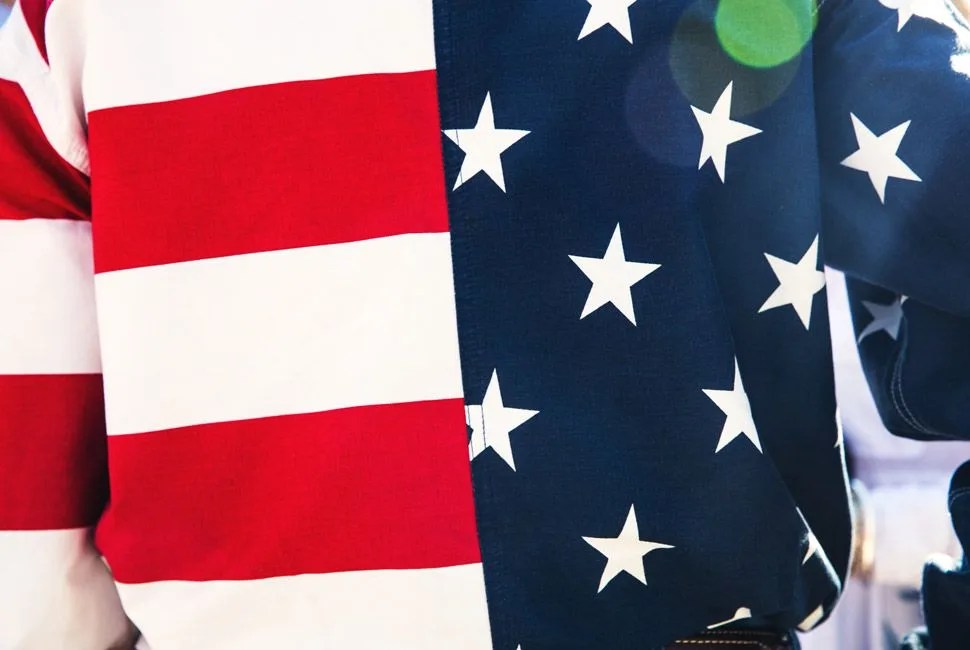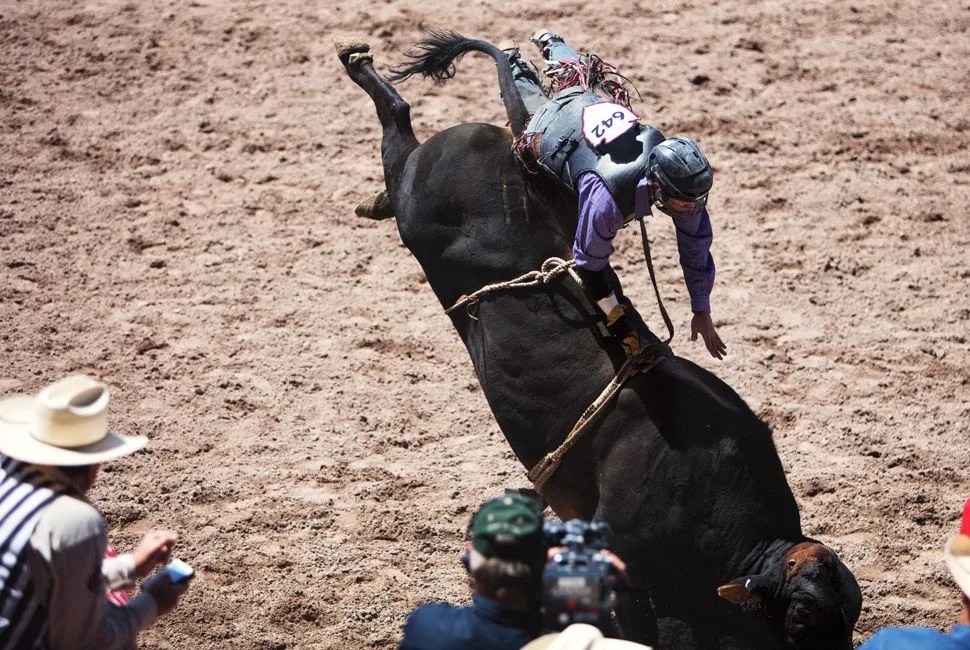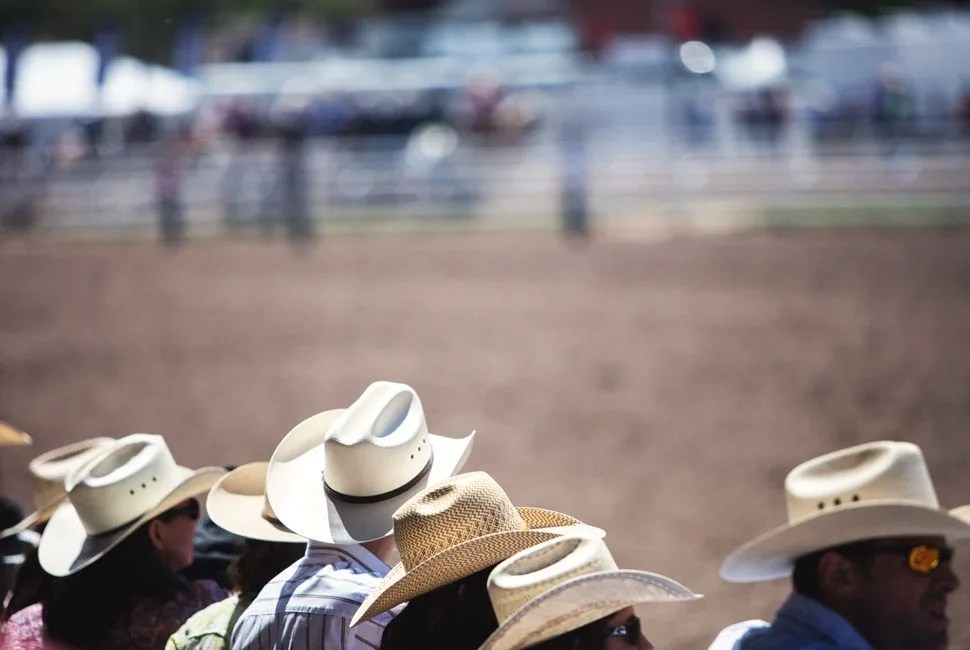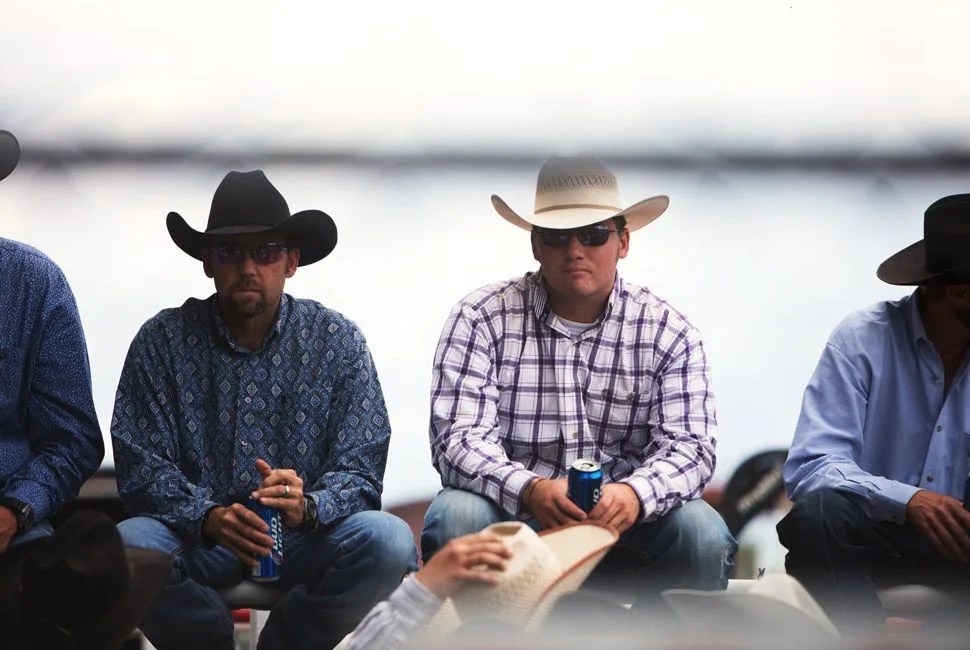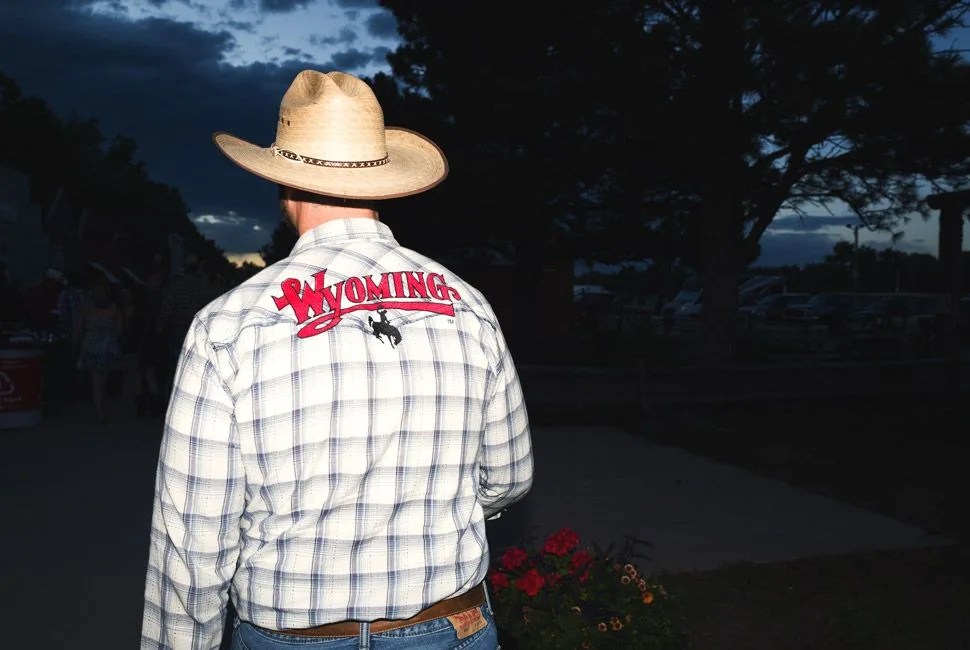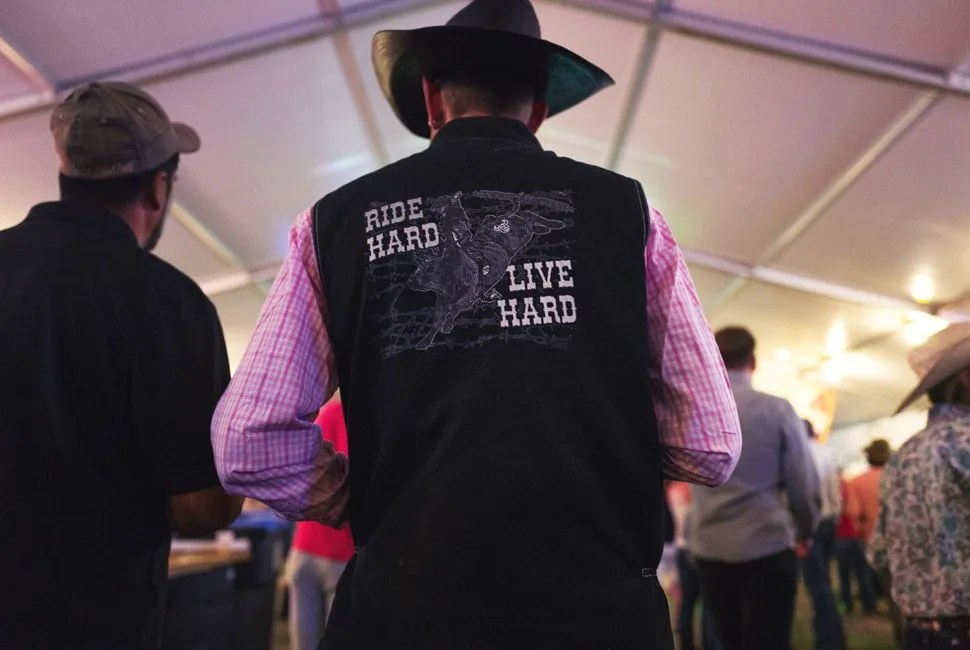Here’s what I know on our very first day in Wyoming, on the eve of the world’s biggest outdoor rodeo: The West is flourishing and potent here like a rattlesnake warming itself on a rock in the summer sun.
Wyoming has already disoriented me. As we drove north from Denver through the empty hill country, past scraps of towns clinging to railroad water stations, oases of cattle sprinkled among hills and washes as far as the eye could see, I realized Montana’s nickname, Big Sky Country, worked just as well here, and was in fact a clever way of saying there was so little to see on the ground that your eyes were forced to the clouds. Then, at dinner, I asked our guide, a native Wyomingite, to explain his state as briefly as he could. “We just like to do cowboy shit and get drunk afterwards,” he said.
This is Cheyenne, Wyoming, population 60,000, capitol building’s dome shining above the treetops, sense of city life practically nonexistent. Cheyenne’s biggest identity today and throughout the year is as the host of Frontier Days, a 10-day rodeo bacchanal. This has happened for 119 years and running. Its existence ties the old and the new together; examine how its line plumbs the dusty past, and you might just see where the West was, and where it’s headed.
The West is flourishing and potent here like a rattlesnake warming itself on a rock in the summer sun.
Frontier Days started in 1897, when a handful of Cattle Barons looking to get Cheyenne noticed rounded up livestock and cowboys and sent out word of a bang-up event. 3,000 people showed up. The first bronco-riding champ, Will Jones, won $25 for his efforts. In 2015, the total prize purse overflows $1 million. That money pairs with big-name recognition to bring the best cowboys around. The rodeo fans — this year, around 90,000 or so, total — are here for the cowboys and their counterparts, the most ferocious, skilled rodeo horses and bulls in the world. The young people and urbanites are here for the buzz and excitement and the performances by Blake Shelton, Miranda Lambert, Big & Rich, and, if they’re old rockers, Aerosmith. (These major-artist concerts are a nascent part of CFD at just six years old.) All those pieces of the cowboy-hat-wearing puzzle, 260,000 in all, are united by Coors Banquet Beer, lariats, danger, excitement, accessibility, cheap thrills and a current of sensibility and tradition that a writer might venture to label: The New Western Life.
6 photos
Before the rodeo is the morning parade, as it’s been done since that first Frontier Days in 1897. There is cowboy shit, but more so, there is horse shit. Caravans of horses and riders decked out in parade-fancy ranch gear swarm the city streets. Local politicians work the stump, slinging gun-toting conservancy and their down-home roots. There are Union soldiers and Native Americans in dance garb and a few high school marching bands brassing and trilling their ways through warmups. The best parts are the Miss Rodeos from a bevy of Western states, riding in sequins and cowboy hats, waving and yelling howdy to the crowd and occasionally hooting, which pleases the crowd plenty but seems unladylike. There is a harrowing re-creation of Raising the Flag on Iwo Jima, where the soldiers are 10 years old and posed atop a moving flatbed truck. There is the smell of hot manure cooking on the pavement.
When the last float lurches around the corner, everyone packs up and moves en masse to the main event, pulled to the city’s stadium in a single herd of smiles and cowboy hats. The stadium’s sprawling grounds are walking distance from the city center, through suburban neighborhoods where homeowners sit in lawn chairs, piling up empty beer cans in their yards. Pamplona can keep its running of the bulls, they seem to say. We’ll stick with our running of the sweaty spectators.
“When you’re in that chute, on that animal, it’s kinda his game,” he says. “You sit there and watch him, feel him. You can feel his heart beat on the inside of your leg.”
The Rodeo is held in a big outdoor stadium, its two sides of bleachers filled with 10,000 or so people. The front entrance is concrete and gates, but coming through the back I see the guts of Western tradition: namely, the labyrinth of animal pens that make the rodeo happen. The bulls are pensive hulks and the broncos stick their big noses through the railings like shy miscreants who just might bite your hand off. Our guide, an ex-steer-wrestler — whom I take a liking to once he describes himself as having the body of a steer wrestler and also the brain of a steer wrestler, and who is built like an NFL linebacker — explains that half a rider’s score comes from the performance of the animal. He believes the bulls and broncs are athletes who are just as excited about the events as the cowboys. I believe him, and realize that I have lost a good chunk of my New York cynicism somewhere a few feet back in the stadium dirt.
On into the bowels of the stadium, where I meet with bareback bronc rider Richmond Champion, who last year at the age of 21 won a million dollars at The American Rodeo in Dallas, Texas. Champion is short, with a neck like a tree trunk, and decked out in semi-formal cowboy wear — hat, baggy paisley button-down, jeans, flat-toed boots. He is friendly and nervous to be interviewed but not scared shitless like he should be an hour before strapping himself to an animal that wants to rid itself of him by any means necessary.
What he says is shocking, but it can’t be far off from the farmstead insight Will Jones would’ve given back in 1897 when he won his 25 bucks. “When you’re in that chute, on that animal, it’s kinda his game,” he says. “You sit there and watch him, feel him. You can feel his heart beat on the inside of your leg… some of ’em will try and flip over and smash you, some will lay down, some stand there like a shy dog. But when you nod your head, you gotta go from being calm and cool to taking care of business, like that.” He snaps his fingers, and I give my own nod, pretending to understand.
16 photos
In the stands, I watch the blue Wyoming sky cook the dirt of the arena to a golden brown. There is a lot of dirt, and a lot of people in the stands, and I am on the side closest to the “chutes” where the bulls are being led in. They trot to their positions like another day at the office. Men in cowboy hats hang on a low scaffolding, and men with numbers on their backs climb one by one onto the backs of the bulls, the electric tautness of their bodies obvious from the distance. Their faces are hard to see, their hats tipped down low, but when their brims do rise it’s not hard to see their lips parted, sucking air like desperate exhaust intakes. The announcers are loud and obnoxious and drawling and full of jokes. “He’s such a hard worker,” one says, matter-of-factly, as the crowd bustles with pre-action, “he quit school ’cause of recess.”
I have seen the rodeo before. Everyone has seen the rodeo before. And yet: this is new. An alien sort of adrenaline and wonder courses through me when the blood and guts of the rodeo happens with the suddenness of the rider’s nod. The gate swings open and the announcers bleat twang out their blowholes and rock music blares over the PA system. I watch the dance. This is what it is: a wild tango-meets-waltz-meets-mosh between the animal, leading, and the rider, following, a touch rocking and wildly tossed, if he does well. If he doesn’t do well, he is whipsawed and whiplashed and finally just whipped.
What this is not is a fight. Not until the rider is thrown and the bullfighter — this is new to me and to the sport, this man who is not a rodeo clown but a warrior in overalls and cleats — flings himself between the angry bull or bronco and the downed cowboy like a crazed martyr, seeking only his own destruction. He protects the cowboy at all costs, darting like a tiny little running back, doubling back and spinning away against a linebacker 100 times his size who has no rules, just fury.
This is what it is: a wild tango-meets-waltz-meets-mosh between the animal, leading, and the rider, following, a touch rocking and wildly tossed, if he does well. If he doesn’t do well, he is whipsawed and whiplashed and finally just whipped.
I feel myself, one with the thousands of Wyoming’s and some of Colorado’s and Idaho’s and Texas’s gazes, directed down at the spectacle on the dirt. This crowd is not raucous. They are focused with a genteel fascination. I am with them in making the feats of the hooved and booted heroes magnified, immediate, mesmerizing. Eight seconds is a blink in our lifetimes, but the meatiness of the bull’s twists and turns, the gymnastics of the bronco’s hoof-flying kicks, stretch the very seconds. Suddenly I get a whiff of why it is that these men and women have kept coming back for 120 years: to everyone here, eight seconds is on its way to an eternity. The truly great cowboys live on for generations — many generations, if they’re absolutely heroic, or absolutely tragic, or both — in the memories of the crowd. Their tossed and stomped forms are fragile and won’t last long otherwise.
5 photos
Then I am lost amid the beer and the people and the men wrestling steers to the ground and the wild flying barrel racers and the beer. Day trots into night. I walk the sprawling grounds, dirt soft under my feet, and out of the sea of cowboy hats emerge smiling faces. Those faces turn toward me, tell me stories: about Lane Frost, best bull rider there ever was, killed by a bull here in Cheyenne at Frontier Days back in 1989. (His last words to his best friend: “That bull just killed me,” the story goes.) About lies told to bring men out to Wyoming: “They said, there’s a pretty girl behind every tree! Then they come out and go, there’s not a fucking tree anywhere in sight!” Words with the Governor, a former team roper himself. The stories of love and trysts-to-be in the dancing tent, cowboys whirling girls, steps flying and bucking they must have learned from the bulls and the broncs. More beer. The humorous story of the mechanical bull, absurd in its slow rollings and wheelings, tossing giggling cowboys and cowgirls into the safety stuffing, a shared joke. The spinning lights of the carnival games and the oily reek of corn dogs, wafting through the insistent Chinook wind.
I come out of a dusty haze and realize it is late and I am at The Outlaw, a modern-style open-air bazaar of a bar. And I no longer remember the subway commute. I no longer can imagine the dull fatigue of a day spent killing brain cells before a computer screen; I no longer know the soul-killing confines of a shoebox apartment’s walls. The West is an erasure of all those distractions.
The bar sprawls across acres and has a bad band playing honky-tonk and corny hip-hop covers. There are drinks for a few useless dollars. There are bathroom conversations between strangers pissing away their hydration about wild, weird women. It is bizarre. It drips and oozes this modern West, in this incomprehensible day and age where men in spurs google roping videos on their smartphones. No one here is trying to figure it out. They’ve done their cowboy shit; now it’s time to get drunk.
